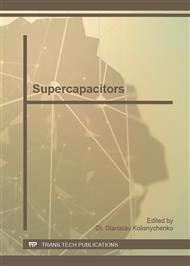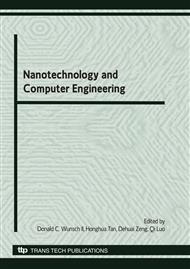[1]
Li Hai-dong, Zhao Yan-lei, et al. Voltage equalizing strategy for supercapacitor in wind power flow optimization and control system[J]. High Voltage Engineering, 35(8): 2006-(2011).
Google Scholar
[2]
LAI J S, LEVY S, ROSE M F, et al. High energy density double-layer capacitors for energy storage applications [J]. Aerospace and Electronic Systems Magazine, IEEE, 1992, 7(4): 14-19.
DOI: 10.1109/62.143193
Google Scholar
[3]
B.E. Conway, et al. Electrochemical supercapacitors-scientific fundamentals and technological applications [M]. Beijing: Chemical Industry Press, 2005. 9.
Google Scholar
[4]
CAHELA D R, et al. Overview of electrochemical double layer capacitors [C], F, (1997).
Google Scholar
[5]
SPYKER R L, NELMS R M. Classical equivalent circuit parameters for a double-layer capacitor.
Google Scholar
[6]
DOUGAL R A, GAO L, LIU S. Ultracapacitor model with automatic order selection and capacity scaling for dynamic system simulation [J]. Journal of Power Sources, 2004, 126(1-2): 250-257.
DOI: 10.1016/j.jpowsour.2003.08.031
Google Scholar
[7]
NELMS R M, CAHELA D R, TATARCHUK B J. Modeling double-layer capacitor behavior using ladder circuits [J]. Aerospace and Electronic Systems, IEEE Transactions on, 2003, 39(2): 430-438.
DOI: 10.1109/taes.2003.1207255
Google Scholar
[8]
MARIE-FRANCOISE J N, GUALOUS H, BERTHON A. Supercapacitor thermal-and electrical-behaviour modelling using ANN [C], F, (2006).
DOI: 10.1049/ip-epa:20050096
Google Scholar
[9]
ZUBIETA L, BONERT R. Characterization of double-layer capacitors for power electronics applications [J]. Industry Applications, IEEE Transactions on, 2000, 36(1): 199-205.
DOI: 10.1109/28.821816
Google Scholar
[10]
FARANDA R, GALLINA M, SON D T. A new simplified model of Double-Layer Capacitors; proceedings of the Clean Electrical Power[C], 2007 ICCEP '07 International Conference on, F, (2007).
DOI: 10.1109/iccep.2007.384288
Google Scholar



